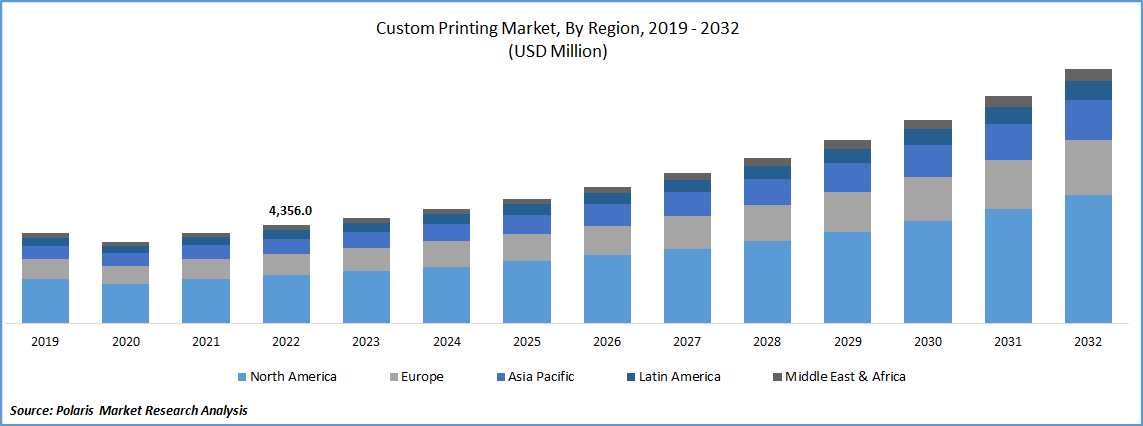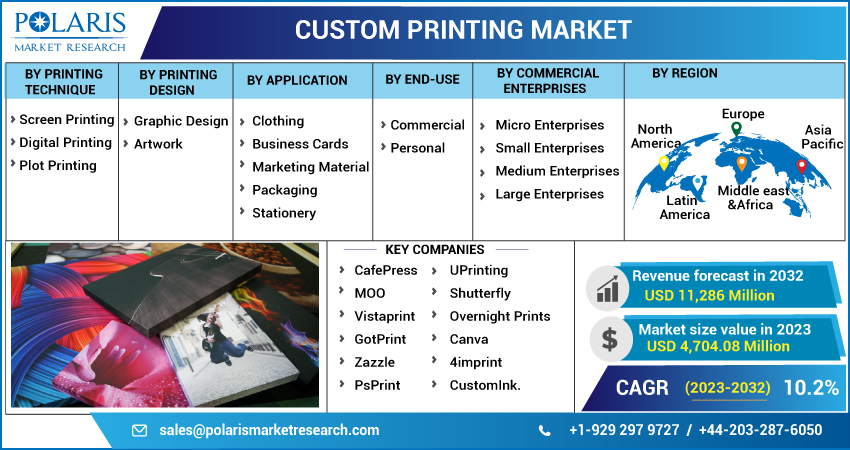
Custom Printing Market Share, Size, Trends, Industry Analysis Report, By Printing Technique (Screen, Digital, Plot); By Printing Design; By Application; By End Use; By Commercial Enterprises; By Region; Segment Forecast, 2023 - 2032
- Published Date:Jun-2023
- Pages: 118
- Format: PDF
- Report ID: PM3334
- Base Year: 2022
- Historical Data: 2019-2021
Report Outlook
The global custom printing market was valued at USD 4,356 million in 2022 and is expected to grow at a CAGR of 10.2% during the forecast period. The rise of online marketplaces has made it easier for consumers to access a wide range of custom printing services. Online platforms such as Etsy and Redbubble have made it easier for small businesses and individual artists to offer custom printing services to a global audience. The market for print on demand is expected to expand over the next few years, according to projections. Analysts predict that until 2030, it will expand at a compound annual growth rate of 26%. The rising demand for customized and short-run items as well as the continuous growth of e-commerce are two reasons that will support this growth.

To Understand More About this Research: Request a Free Sample Report
Product customization has led to increased demand for custom printing services. Consumers are looking for unique, personalized products that meet their individual needs and preferences. According to gokickflip, consumers generally view product customisation as advantageous. In fact, 81% of people are willing to pay more for customized clothing, 79% for footwear, 76% for furniture, and 77% for jewelry and fashion accessories. This will further create a wide range of opportunities for the growth of the custom printing market in upcoming years.

For Specific Research Requirements, Request For Customized Report
Industry Dynamics
Growth Drivers
Businesses and consumers are increasingly seeking customized printed materials that are tailored to their specific needs and preferences, from personalized marketing collateral and promotional items to customized packaging and labels. Customization reigns supreme in terms of methods to stand out. For both brands and customers, it offers limitless possibilities. Thus, it is expected that by 2027, the global e-commerce sector will be worth $27.15 trillion, according to Forbes. Small and medium-sized enterprises' future depends on custom products.
The development of advanced printing technologies, such as digital printing and 3D printing, has made it easier and more cost-effective to produce customized printed materials. For instance, inkjet printers, its beginning cost is modest. High-quality photos can be printed using even inexpensive inkjet printers. This will further create a wide range of opportunities for the printing industry in the coming years.
Report Segmentation
The market is primarily segmented based on printing technique, printing design, application, end use, commercial enterprises, and region.
|
By Printing Technique |
By Printing Design |
By Application |
By End Use |
By Commercial Enterprises |
By Region |
|
|
|
|
|
|
To Understand the Scope of this Report: Speak to Analyst
Screen Printing Segment is Expected to Witness Fastest Growth During Forecast Period
Screen Printing segment is expected to have higher growth in the study period. due to its versatility and cost-effectiveness. Screen printing is a process that involves applying ink onto a substrate through a stencil or mesh screen, creating a sharp, vibrant, and durable print. Additionally, advances in technology have made screen printing more efficient and accessible. For example, automated screen-printing machines can now produce high-quality prints at a faster rate than traditional manual methods. This has made it easier for businesses of all sizes to enter the custom printing market and offer high-quality, affordable custom products.
Graphic Design Accounted for the Largest Revenue Share in 2022
Graphic Design segment is projected to have larger revenue share in 2022. The growth of the graphic design segment has been fueled by advances in technology that have made it easier and more accessible for people to create high-quality designs. Design software such as Adobe Creative Suite and Canva have made it possible for individuals with little to no design experience to create professional-looking designs. In addition, the rise of online marketplaces and print-on-demand services has made it easier for graphic designers to sell their designs and for customers to access a wide range of customizable products. This has created new opportunities for graphic designers to monetize their skills and for businesses and individuals to access high-quality custom printing services.
Clothing Segment is Expected to Hold the Significant Revenue Share in 2022
Clothing segment is driving the growth of the custom printing market by creating new opportunities for designers and entrepreneurs. Custom clothing designs have become increasingly popular, and many independent designers and small businesses have emerged to meet this demand. This has created new opportunities for custom printing businesses to partner with these designers and entrepreneurs to produce high-quality custom apparel. Custom printed clothing has become increasingly popular for personal use, with individuals seeking unique and personalized clothing designs.
Commercial Segment is Projected to Witness Higher Growth Rate During Projected Timeframe
Commercial segment is expected to drive growth in the custom printing market by creating new opportunities for businesses to promote their brand and message through custom printed materials. Custom printing services for commercial use include a wide range of products such as business cards, brochures, flyers, banners, signage, and more. Moreover, custom printing services have become more accessible and affordable, making it easier for businesses of all sizes to create high-quality printed materials. Online marketplaces have made it easier for businesses to access custom printing services, and advances in technology have made the process faster and more efficient. This will further create a wide range of opportunities for the growth of the market in coming years.
Large Enterprises Garnered with the Largest Market Share in 2022
Large enterprise segment is projected to have a larger market share for custom printing market as it has significant printing needs, ranging from marketing collateral and promotional materials to internal documents and communications. With the rise of digital printing technologies, it has become easier and more cost-effective for large enterprises to produce customized printed materials in-house or through outsourced print providers. In addition, large enterprises tend to have larger budgets and greater purchasing power than smaller businesses or individuals, which can enable them to invest in high-quality printing solutions and services. This can include custom printing solutions that are tailored to their specific needs and requirements.
APAC Registered Highest Growth Rate Throughout the Forecast Period
APAC is projected to experience a higher growth rate throughout the study period. This region has a large and rapidly growing population, which is driving demand for a wide range of printed materials, from books and magazines to packaging and promotional materials. According to McKinsey insights, by 2030, up to 200 million Indonesians, up from 120 million currently, may be classified as consumers. As more businesses establish a presence in the region to serve this growing population, the demand for customized printing solutions is also expected to increase.
Competitive Insight
Some of the major players operating in the global market include CafePress, MOO, Vistaprint, GotPrint, Zazzle, PsPrint, UPrinting, Shutterfly, Overnight Prints, Canva, 4imprint & CustomInk.
Recent Developments
- In March 2023, Zazzle, introduced original designs on demand items, and also announced addition of instant downloads for the invitations & customized designs.
- In October 2021, The Vistaprint company acquired Crello, an online graphic design editor that competes with Canva and its parent company Desposit photos, as well as another online graphic design editor.
Custom Printing Market Report Scope
|
Report Attributes |
Details |
|
Market size value in 2022 |
USD 4,704.08 million |
|
Revenue forecast in 2032 |
USD 11,286 million |
|
CAGR |
10.2% from 2023 – 2032 |
|
Base year |
2022 |
|
Historical data |
2019 – 2021 |
|
Forecast period |
2023 – 2032 |
|
Quantitative units |
Revenue in USD million and CAGR from 2023 to 2032 |
|
Segments covered |
By Printing Technique, By Printing Design, By Application, By End Use, By Commercial Enterprises, By Region |
|
Regional scope |
North America, Europe, Asia Pacific, Latin America, Middle East & Africa |
|
Key companies |
CafePress, MOO, Vistaprint, GotPrint, Zazzle, PsPrint, UPrinting, Shutterfly, Overnight Prints, Canva, 4imprint & CustomInk. |
FAQ's
The global custom printing market size is expected to reach USD 11,286.04 billion by 2032.
Key players in the custom printing market are CafePress, MOO, Vistaprint, GotPrint, Zazzle, PsPrint, UPrinting, Shutterfly, Overnight Prints, Canva, 4imprint & CustomInk.
Asia Pacific contribute notably towards the global custom printing market.
The global custom printing market expected to grow at a CAGR of 10.21% during the forecast period.
The custom printing market report covering key segments are printing technique, printing design, application, end use, commercial enterprises, and region.
